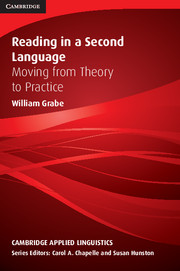Book contents
- Frontmatter
- Contents
- Series editors' preface
- Preface
- I FOUNDATIONS OF READING
- II PATTERNS OF VARIATION IN READING
- III DEVELOPING READING COMPREHENSION ABILITIES
- IV EXPANDING READING COMPREHENSION SKILLS
- Chapter 14 Reading fluency, reading rate, and comprehension
- Chapter 15 Extensive reading
- Chapter 16 The reading curriculum and instruction
- Chapter 17 Reading assessment
- Chapter 18 Further topics and issues in reading
- References
- Author Index
- Subject Index
Chapter 16 - The reading curriculum and instruction
from IV - EXPANDING READING COMPREHENSION SKILLS
Published online by Cambridge University Press: 05 August 2012
- Frontmatter
- Contents
- Series editors' preface
- Preface
- I FOUNDATIONS OF READING
- II PATTERNS OF VARIATION IN READING
- III DEVELOPING READING COMPREHENSION ABILITIES
- IV EXPANDING READING COMPREHENSION SKILLS
- Chapter 14 Reading fluency, reading rate, and comprehension
- Chapter 15 Extensive reading
- Chapter 16 The reading curriculum and instruction
- Chapter 17 Reading assessment
- Chapter 18 Further topics and issues in reading
- References
- Author Index
- Subject Index
Summary
Teaching students how to utilize the skills and knowledge they bring from their first language, developing vocabulary skills, improving reading comprehension, improving reading rate, teaching readers how to orchestrate the use of strategies and how to monitor their own improvement are some of the elements that teachers must consider in preparing for an EFL/ESL reading class.
(Anderson, 1999: 1)Over the first 15 chapters, many implications for instruction have been suggested. They reflect research results and what we now understand about the nature of reading abilities and how they develop. One conclusion to draw from these chapters is that reading comprehension and its development are very complex. Added to this complexity is the variability of instructional possibilities, teacher orientations, and student engagement. One of the major issues facing teachers, teacher trainers, curriculum developers, administrators, and materials writers is how to determine the most efficient and effective instructional approach for reading improvement that also achieves institutional goals. In this chapter, we explore briefly major implications for reading instruction; these include (a) specific suggestions for carrying out reading instruction that draws on research findings and (b) ways to build coherent curricular approaches that maximize learning.
Implications for instruction from research
Overall, the combination of research on L1 and L2 reading suggests that there are a number of important implications for L2 reading instruction. Most fundamentally, reading comprehension requires the 12 skills and knowledge resources identified in Table 16.1.
- Type
- Chapter
- Information
- Reading in a Second LanguageMoving from Theory to Practice, pp. 329 - 351Publisher: Cambridge University PressPrint publication year: 2008



